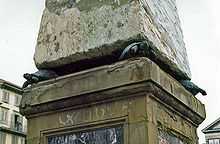World Turtle

The World Turtle (also referred to as the Cosmic Turtle, the World-bearing Turtle, or the Divine Turtle) is a mytheme of a giant turtle (or tortoise) supporting or containing the world. The mytheme, which is similar to that of the World Elephant and World Serpent, occurs in Chinese, and Native American mythology. The "World-Tortoise" mytheme was discussed comparatively by Edward Burnett Tylor (1878:341).
India
An example of a reference to a World Turtle in Hindu literature is found in Jñānarāja (the author of Siddhāntasundara, writing c. 1500): "A vulture, which has only little strength, rests in the sky holding a snake in its beak for a prahara [three hours]. Why can [the deity] in the form of a tortoise, who possesses an inconceivable potency, not hold the Earth in the sky for a kalpa [billions of years]?"[1] The British philosopherJohn Locke made reference to this in his 1689 tract An Essay Concerning Human Understanding which compares one who would say that properties inherent in "substance" to the Indian who said the world was on an elephant which was on a tortoise "but being again pressed to know what gave support to the broad-backed tortoise, replied — something, he knew not what."[2]
China
In Chinese mythology, the creator goddess Nüwa cut the legs off the giant sea turtle Ao (鳌) and used them to prop up the sky after Gong Gong damaged the Buzhou Mountain that had previously supported the heavens.
North America
The Lenape myth of the "Great Turtle" was first recorded between 1678 and 1680 by Jasper Danckaerts. The myth is shared by other Northeastern Woodlands tribes, notably the Iroquois.[3]
References
- ↑ Toke L. Knudsen, Indology mailing list.
- ↑ Locke, John (1689). An Essay Concerning Human Understanding, Book II, Chapter XXIII, section 2
- ↑ Why the World is on the Back of a Turtle - Miller, Jay; Man, Royal Anthropological Institute of Great Britain and Ireland, New Series, Vol. 9, No. 2 (Jun., 1974), pp. 306–308, including further references within the cited text)
See also
- Great A'Tuin—the World Turtle in Terry Pratchett's Discworld
- Kurma—the turtle avatar of Vishnu
- Turtles all the way down